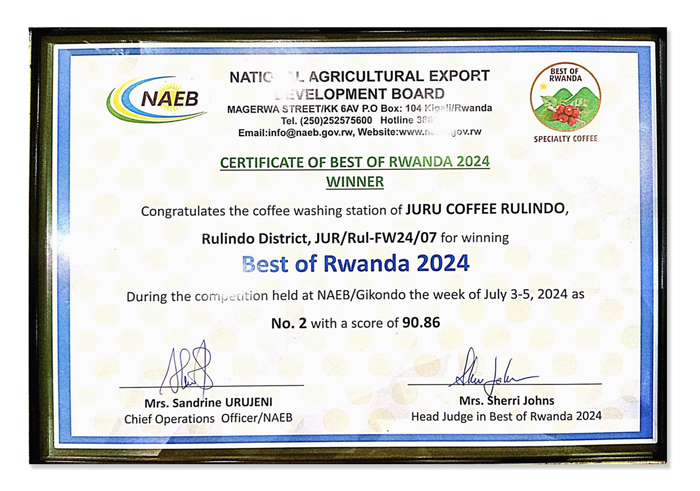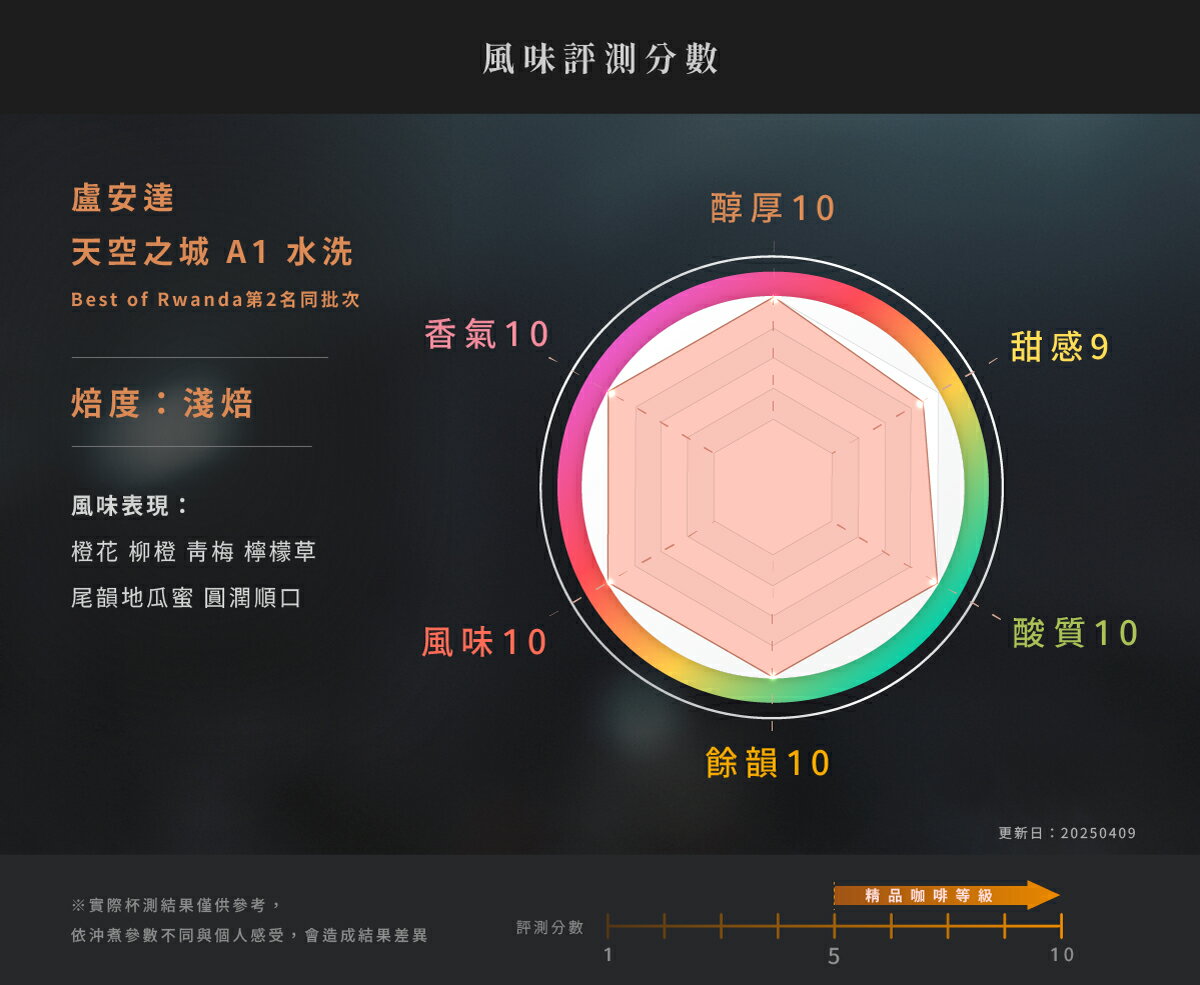

※ Rwanda Rulindo Juru A1 Sc 15+ achieved an impressive second place at the Best of Rwanda competition with a score of 90.86 points.
Best of Rwanda is a national specialty coffee competition organized by Rwanda's NAEB (National Agricultural Export Development Board). Its aim is to strengthen the quality of specialty coffee across Rwanda and promote Rwandan coffee in the international market by connecting producers with international buyers through auctions.

Rwanda Rulindo Juru A1 Sc 15+. Three processing methods available for selection.
-------
※ Rwanda Rulindo Juru A1 Sc 15+
Rwanda Northern Province Rulindo Juru A1 Sc 15+ Washed

-------
Rwanda NPR Rulindo Juru A1 Sc 15+ Honey
-------
Rwanda NPR Rulindo Juru A1 Sc 15+ Natural







Coffee Flavor
The flavors of coffee are derived from the breakdown of various nutrients in the green coffee beans during roasting. Heat causes these compounds to degrade into a variety of aromatic molecular structures, resulting in a wide spectrum of flavors. High-quality coffee beans naturally possess a rich aroma that evolves at different temperatures—high, medium, and low—offering a delightful and nuanced experience worth savoring.
Rwanda Northern Province Rulindo Juru A1 Sc 15+ Washed
Orange blossom, Orange, Green Plum, Lemongrass, with a lingering finish of Sweet Potato Syrup, Smooth and rounded mouthfeel.
----
Rwanda NPR Rulindo Juru A1 Sc 15+ Honey
Osmanthus Oolong Tea, Citrus, Cranberry, Light roasted Tea Aroma, with a lingering finish of Hazelnut Chocolate Sweetness. Smooth, mellow, and well-balanced acidity and sweetness.
----
Rwanda NPR Rulindo Juru A1 Sc 15+ Natural
Wine-Soaked Cherry, Peach, Dark Berries, Cherry, Citrus, Dried Apricot, Lingering Candied Fruit and Caramel Sweetness. Complex and dynamic.

Rwanda, a small landlocked country in East Africa, is known as the "Land of a Thousand Hills" due to its mountainous and plateau terrain. Its hilly environment, fertile soil, excellent climate, and rainfall create an ideal coffee-growing environment, resulting in beans with a rich flavor profile.
Around 2010, Rwanda became the first African nation to host the Cup of Excellence competition. Due to its limited national coffee cultivation area and inability to mass-produce, the country shifted its focus to developing specialty coffee, with flavors that rival renowned African origins like Yirgacheffe or the premium coffees of Kenya.
Rulindo District is located in Rwanda's Northern Province. This particular coffee originates from the high-altitude mountains within the Rulindo District, with coffee cherries grown at elevations ranging from 1700m to 2300m in the smallholder backyards surrounding the Muyanza Dam. The washing station is situated at an altitude of 1717m, and its water source comes from a high mountain spring at 1892m.
This region experiences two dry seasons and two rainy seasons annually, with a consistently mild climate and abundant rainfall. Even during the dry seasons, the coffee trees flower, and the harvest period is concentrated between March and June. The coffee-growing areas of Rulindo District feature fertile sandy soil and a unique geographical environment, which contribute to the coffee's distinctive fruit notes and vibrant aromas, such as strawberry, apricot, and lemon. The cup profile is smooth, round, and sweet, offering a different flavor experience compared to Kenyan and Ethiopian coffees.
The three processing methods employed here each yield unique flavor characteristics, with full-bodied and expressive fruit aromas that are truly captivating. This exceptional coffee has been named "Juru" – coffee from paradise.
【Friendly Farming, Organic Cultivation】
Smallholder farmers here are committed to organic and environmentally friendly coffee cultivation. They utilize livestock waste for fertilizer, employ organic herbicides, and have introduced water-efficient Penagos depulping machines for post-harvest processing, minimizing their environmental impact. Following the devastating Rwandan genocide of 1994, in which approximately 800,000 people perished, Rwandan farmers have worked tirelessly to rebuild their lives. Green bean buyers aim to strengthen community ties, improve the quality of smallholder coffee, and secure better prices. This, in turn, allows farmers to invest in their children's education and their communities, breaking the cycle of poverty. In 2023, the green bean buyer added three clean water stations around their Rulindo washing station, providing clean drinking water to residents as a way of giving back and improving their quality of life.
【Rwanda Grading System: A, B, C】
Rwandan coffee is graded based on density. Grade A represents the highest density, and is further divided into specialty grades A1 and A2, and commercial grade A3. Following this are grades B and C. Higher density indicates a more solid bean structure, more complete flavor development, and superior quality. This particular lot features the highest quality A1 grade Rwandan specialty coffee.

Arabica Coffee Variety –Bourbon
The Arabica coffee variety Bourbon is currently one of the closest to the native species and is found in Reunion (originally named Bourbon) off the island of Madagascar. Bourbon has its own characteristics and has the same high-quality taste as Typica, with a sour taste like red wine and a sweet aftertaste. Tiberica and Bourbon can be distinguished from the leaves and bean appearance of the coffee tree. The leaves of Bourbon are wider, and the coffee cherries are smaller and denser, so the appearance of the beans is smaller and rounder than Tiberica. In Kenya and Tanzania, Bourbon progeny was used to artificially mix, and "SL28" and "SL34" artificial new varieties appeared, which are famous for their good flavor performance. Although the yield of bourbon is higher than Typica, the harvest period is also 2 years, and it can be regarded as a variety with less output.
 (Coffee Processes)
(Coffee Processes)
The term "processing methods" refers to the process of transforming ripe red coffee cherries into dried green beans. Each method has its advantages and disadvantages, influenced by the natural environment and the specific needs of the coffee-producing region. As a result, different regions adopt the processing method most suited to their conditions. This batch uses the following three processing methods, described below:
【Washed / Wet Processed】
Also known as the wet process, this method involves removing the skin and pulp of the coffee cherries before drying. The seeds are then fermented in water tanks to eliminate the remaining mucilage on their surface, followed by thorough washing and drying under sunlight or with mechanical dryers.
The washed process produces a cleaner and crisper flavor profile compared to the natural process. Coffees processed this way typically have lighter body, brighter acidity, and distinct fruit flavors. This method is often associated with specialty coffee due to its clarity and vibrant flavor expression.
【Honey / Pulped Natural / Semi-dry Process】
The honey process is a method that combines elements of both the natural process and the washed process. This technique was initially developed in Costa Rica. Similar to the washed process, the skin and pulp of the coffee cherries are removed, but the fermentation step is skipped. Instead, the mucilage layer (a sticky, sugary layer around the bean) is left intact and dried under sunlight.
The term "honey" does not refer to the addition of actual honey. Rather, it derives from the sticky texture of the mucilage, which resembles honey. The retention of this layer, rich in sugars and acids, is the key to the honey process. The amount of mucilage left on the beans determines the sweetness and flavor complexity.
The flavor profile produced by the honey processing method lies between that of the natural (sun-dried) and washed processes, resulting in a very unique cup of coffee. The taste is cleaner than the natural process, and due to the residual mucilage, it also has a richer syrupy sweetness. The acidity is more pronounced than in washed coffees, but the body is richer and more full-bodied than that of washed coffees.
【Natural Process / Sundried / Dry Processed】
Also known as the natural drying method or unwashed process, the natural process is one of the most traditional and widely used methods of coffee processing. This method does not involve the use of water. Originating in Ethiopia, coffee cherries are harvested and laid out to dry under the sun before being hulled. The seeds remain inside the fruit throughout the extended drying period, absorbing flavors from the skin, pulp, and mucilage. This process enhances the coffee's sweetness and body, often resulting in unique and distinctive aromas.
Producers spread the cherries on drying beds, which may consist of terraces or raised platforms. Over the course of 3 to 6 weeks, the cherries undergo fermentation. Producers turn the cherries regularly to ensure even drying and to prevent spoilage. During this time, the sugars in the fruit and the mucilage adhered to the seeds develop complex flavors, contributing to a sweeter profile.
Once dried, the fruit layers are mechanically removed from the seeds. Natural-processed coffee is often juicy and syrupy, with a rich flavor that makes the effort behind this method well worth it.
------
Juru Green Bean Processing Procedure Introduction:
After farmers deliver fresh coffee cherries to the washing station, the first step involves meticulous pre-sorting. Overripe, unripe, insect-damaged, yellow, green, and frost-damaged cherries, along with non-cherry materials like twigs and stones, are removed. Following this initial hand-sorting, the cherries are transferred to a flotation tank. This process separates the less dense, floating beans from the denser beans that sink to the bottom. The submerged cherries are then conveyed to a Penagos depulping machine for the removal of the outer skin. These depulped, parchment-covered beans undergo a 12-hour fermentation period. Subsequently, they are graded from A1 to A4 based on density using the water's buoyancy in channels. The densest A1 beans are then moved to a pre-drying shade for an intensive second hand-sorting, lasting 24 to 48 hours. Finally, the beans are transferred to African drying beds for sun drying. To prevent damage from high temperatures and humidity, the parchment-covered beans are typically covered between 12:00 PM and 2:00 PM and during rainfall. The average drying period lasts approximately 15 to 20 days. Once the moisture content reaches the ideal range of 10.5%, the parchment beans are collected, recorded, bagged, and stored in the warehouse.





JUSTIN INTERNATIONAL FOOD ENTERPRISE CO., LTD.
Tel: +886-3-358-6611
1st Floor, No. 30, Lane 120, Daxing Road, Taoyuan District, Taoyuan City
▶This product is covered by a NT$10 million product liability insurance.
▶Food Industry Registration Number: F-165601955-00000-0
▶ Our company’s cupper is certified as a CQI International Coffee Quality Appraiser.



Recommended Products

※ For detailed shipping and payment information, invoices, overseas ordering instructions, etc., please click here to enter.
